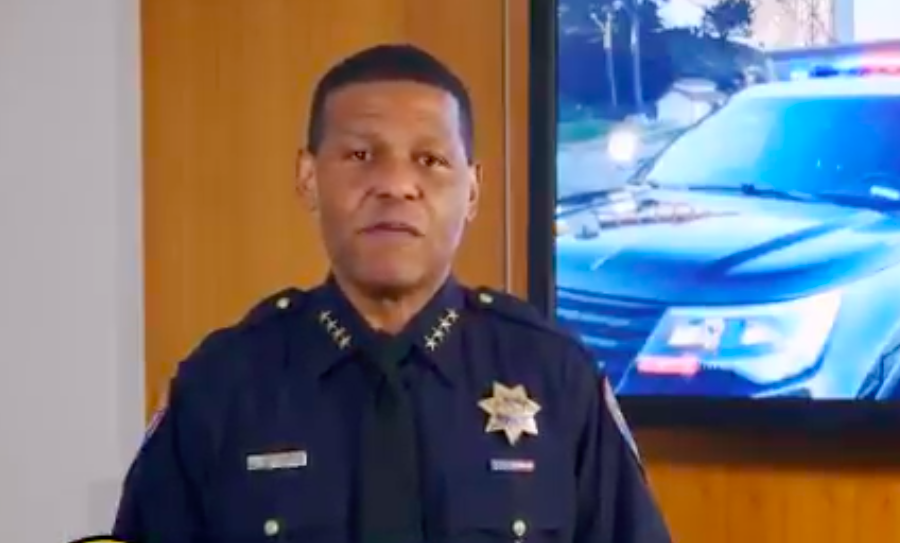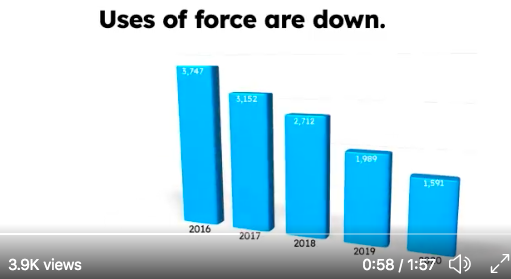Mayor London Breed and Police Chief Bill Scott held a press conference Monday to discuss the real data on crime in SF – in many cases, it’s actually down from a couple of years ago. The chief also took the opportunity to make the case that he needs … more cops.
And the mayor was standing there showing support for his plea that the city needs to hire 400 more sworn officers.

This was the latest episode in an ongoing campaign by the SFPD to build public support for increasing the size of the force at a time when many cities and community activists are talking about defunding police.
It follows a well-produced video that the department produced advocating that the supervisors fund more officers (the board didn’t give the mayor all the cops she wanted, but did agreed to increase, not decrease, SFPD funding.)
On the surface, the point of the Monday event was to counter the national narrative that San Francisco is a lawless nightmare. (I was in an auto parts store in upstate New York last month, not long after the video of the guy on the bike at Walgreens went viral, and when the man at the counter saw my SF-logo debit card, he asked if I live in San Francisco. When I told him I did, he mentioned the video and said: “You have my deepest sympathy.”)
The chief and the mayor pointed out that in many categories, serious crime has declined over the past two years in San Francisco. Homicide is up slightly; sexual assault and robbery are down.
Despite the viral videos, the chief said, “San Francisco is a safe city.” (Oh, and by the way: The guy on the bike was arrested and is now in jail.)
But there’s a lot more to this story. Some of what’s in the promotional video is simply untrue.
Help us save local journalism!
Every tax-deductible donation helps us grow to cover the issues that mean the most to our community. Become a 48 Hills Hero and support the only daily progressive news source in the Bay Area.
For example:
The video says that use of force by SFPD officers is down “substantially.” Here’s the graphic:

But as longtime police-practices lawyer and expert John Crew noted in a letter to the supes:
The entirety of their claimed use of force “reduction” is attributable to a single reform implemented several years ago. When SFPD finally joined other major police agencies in requiring officers to log when they drew and pointed their firearms, the overall reported uses of force predictably skyrocketed and then gradually declined in subsequent years as the “stop and think” effect of the reporting requirement made officers and the department recognize that firearms were being drawn unnecessarily and far too frequently. This is the same data pattern shown by other agencies in the years immediately after this same reform was implemented. It’s great that SFPD officers are finally drawing their firearms less frequently. But it is deeply misleading and cynical to claim uses of force are down overall when the data trend being depicted is explained entirely by the one-time huge increase shown in the 2016 data caused solely by the new duty to report this category of force and by the predictable effect of the reform — only on this type of force — in subsequent years.
In fact, in the last quarter of 2019, the department’s own report shows only a 2.6 percent decrease in overall use of force between 2016 and 2019.
Scott made a big deal of a New York Times article that used data to show a decline in the number of police killings in major cities – including San Francisco. He referenced it in the video, and again during his press conference. He said that article was sign that San Francisco is making huge progress in reforms.
But the same statistician who noted those reforms on use of force had a different message when it comes to racism in policing – in San Francisco. In fact, according to the data, San Francisco is one of the worst big cities in the country when it comes to racial disparities in arrests and killings.
Again, from John Crew:
In other words,the SFPD’s source for its claim that it’s now a national model for police reform actually says the direct opposite— that SFPD has failed to meaningfully address its long-standing practice of engaging in extremely racially disparate policing.
Far from making “groundbreaking strides” in this area, SFPD continues to drag its heels and refuses to pursue best practices recommended by the State of California and a variety of “best practices” experts in the field of law enforcement. And notwithstanding its claimed devotion to “community policing,” SFPD had shown little interest in recommendations that have been touted repeatedly by community voices and experts that have proven elsewhere to reduce the sort of de facto racist policing that SFPD chooses to continue to still practice
That’s why, according to the most current figures the SFPD has released, the SFPD is still six times more likely to stop, 11 times more likely to search, and 12 times more likely to use force on African Americans than whites.
You can argue that it’s the chief’s job to lobby for more money for his department. But it’s the job of the elected officials who oversee the SFPD to look at the facts, which include this, again from Crew:
Over roughly the last decade the SFPD has already successfully and massively expanded its budget by an inflation-adjusted one-third, gobbling up an additional $170 million each year in local taxpayer funding and adding a whopping 500 employees to its ranks. During this same time period, new contracts for all ranks of the department have repeatedly awarded significant pay and benefit boosts on top of compensation packages that the [police union] leadership had already described as the most generous in the country. In short, San Francisco is already paying top dollar for what should — based on cost and our local values — be among the most modern, professional, effective, fully transparent, community-oriented, minimally violent and racially equitable policing in the country.
And that’s not what we’re getting for our money.
PS: The Chron put at the top of its front page today a new report saying that some people accused of crimes and released without bail go on to commit other crimes or not show up for trial. Already, I’m seeing on social media complaints that this is the fault of the district attorney, who has argued that cash bail discriminates against poor people and people of color. Which is true.
You have to go deep into the story to learn that the study looked at data from 2016 to 2019, before Chesa Boudin took office – so it has nothing to do with his policies.
In fact, the changes that allowed more people to go free while awaiting trial were adopted under DA George Gascon.
I think it’s pretty axiomatic that if you lock up everyone who can’t afford high cash bail after they are arrested, none of them will go an commit another crime, and all of them will show up for their court hearings.
It’s also axiomatic that many will lost their jobs, their homes, their kids while stuck in jail awaiting trial – and after they are released (either after an innocence finding at trial or after completing a prison sentence) they will be far, far less stable and more likely to commit another serious crime.
The study doesn’t look at that.



